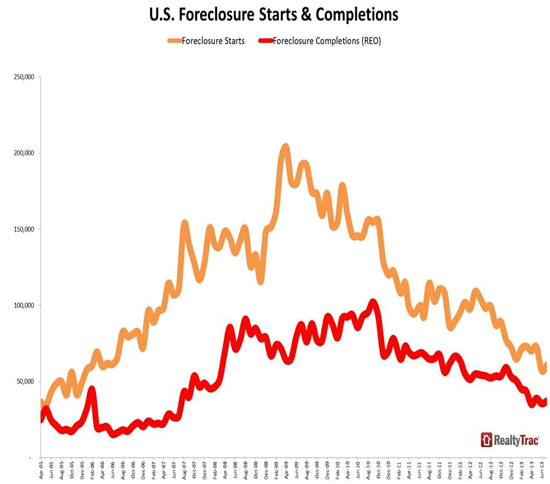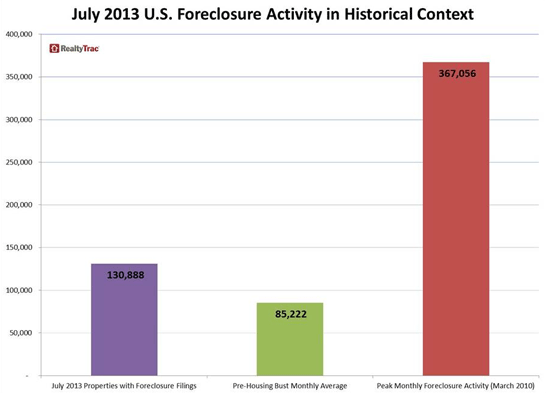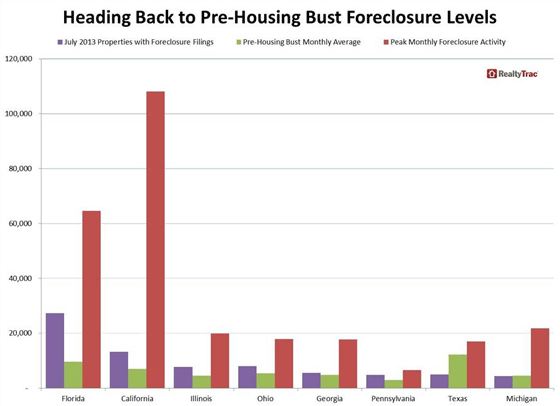Foreclosure activity accelerated slightly in July rising off of the 78 month low it reached in June, RealtyTrac said today. There were 130,888 foreclosure filings - including default notices, scheduled auctions, and bank repossessions - in June, the Irvine, California company reported, a 2 percent increase from the previous month but a level 32 percent below that in July 2012. One in every 1,001 U.S. Housing units received a foreclosure filing during the month.
The slight increase in overall national activity was driven by filings in the later stages of the foreclosure process. Foreclosure starts increased by 6 percent from July and bank repossessions were up 4 percent although both were down compared to July 2012.

RealtyTrac focused its July report on state level statistics and the state that is at the epicenter of activity continues to be Florida. Foreclosure activity there increased 8 percent from the previous month and was up 7 percent from a year earlier. There have been month-over- month increases in foreclosure filings in the state for 16 of the last 19 months and it is the number one state for foreclosure activity for the third consecutive month with a filing rate three times the national average. Foreclosure starts decreased 28 percent from a year ago but scheduled auctions were up 74 percent and completed foreclosures 13 percent on an annual basis.
In all there were increases in foreclosure starts in 26 states and bank repossessions were up in 29 states compared to June. On a year over year basis starts were up in 15 states and bank repossessions in 18 states. The largest increase in starts was in Maryland which had nearly a three-fold increase (+275 percent) compared to July 2012 and was the state with the second highest level of overall activity. Starts were up in Oregon by 137 percent and New Jersey by 89 percent.
Bank repossessions skyrocketed in Arkansas with an annual increase of 266 percent, Oklahoma, up 126 percent, Maryland (+101 percent) and New York (100 percent).
Second place Maryland had 3,962 foreclosure filings during the month, an increase of 148 percent from a year earlier. Ohio, in third place, actually posted a year-over-year decrease in foreclosure activity for July and the preceding two months but still had foreclosure filings on one in every 639 housing units in the state in July.
Chief among states with improving statistics was Arizona which dropped out of the top ten states for foreclosure activity for the first time since February 2007. California and Michigan had previously relinquished their top ten spots and maintained their lower tier status in July for the sixth and fifth consecutive months respectively.
Nine of the nation's 10 highest metro foreclosure rates in July were in Florida cities, and five of those nine Florida cities posted increasing foreclosure activity from a year ago.
"While foreclosures are continuing to boil over in a select group of markets where state legislation and court rulings kept a lid on foreclosure activity during the worst of the housing crisis, the foreclosure boil-over markets are becoming fewer and farther between as lenders have caught up with the backlog of delayed foreclosures in some of the states with the more lengthy judicial foreclosure process," said Daren Blomquist, vice president of RealtyTrac. "For example, Illinois foreclosure activity has now decreased on a year-over-year basis for eight consecutive months following 11 straight months of annual increases, and Ohio has seen three consecutive months with annual decreases following eight straight months with annual increases.

"U.S. foreclosure activity in July is 64 percent below the peak of more than 367,000 properties with foreclosure filings in March 2010, but is still 54 percent above the historical average of 85,000 properties with foreclosure filings per month before the housing bubble burst in late 2006," Blomquist continued. "There are a dozen states, however, where foreclosure activity levels in July were at or below average monthly levels prior to the bubble bursting. Those states include Texas, Colorado, Oklahoma, Indiana and Michigan, and we expect the number of states in this category to increase in the coming months."








